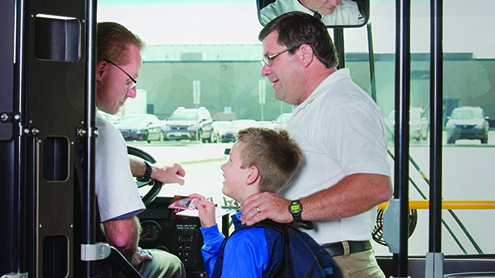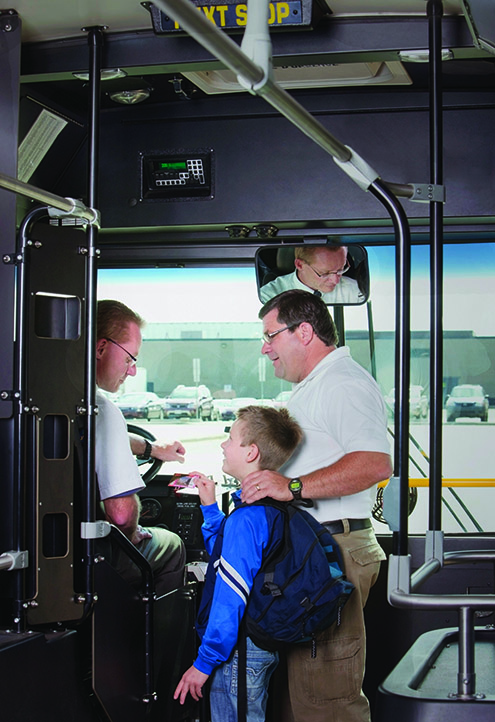

Trends and technologies that change transit thinking
By Michael J. Wilson
At the request of BUSRide, ACCENTURE answered four critical questions that show how open-architecture technology is driving next-generation transportation.
What are some of the trends and technologies that transit providers embrace to offer commuters next-generation transportation services?
Current trends and technologies tend to cluster around three key themes. The first relates to transit providers “going mobile” to engage their customers in new ways that both improve and simplify their transit experience. It is not necessarily about creating mobile apps but more about embracing mobile-related partnerships that result in published schedules, trip information, general statistics and partnering with key technology suppliers. It also means mobile ticketing, paying with a mobile wallet and providing real-time train and bus trip information.
The second key area is for transit agencies to “think like a retailer.” While elements of transit are unique, such as dynamic pricing of high-volume, low value transactions within milliseconds, they don’t necessarily exclude transit providers borrowing from the best practices among retailers. Some forward-thinking agencies are viewing the transit experience in the same way a retailer provides for customers. Approaches like loyalty programs, related partnerships and the application of analytics help them better understand customer segments, as well as what motivates them to take transit — or to leave it alone. Agencies are using customer account management that allows them to offer greater diversity in products and payment methods, as well as flexible payment architectures.
This last area is growing rapidly as organizations realize by using open payments or mobile payments they can give customers the choices they expect. Retailers have set customer expectations. Now transit authorities must find ways to satisfy them. A third emerging area is proactive asset management. Transit agencies manage a broad range of capital assets yet they face an ever-increasing need to manage those assets cost-effectively. As a result, agencies are taking a lesson from other big asset management providers — such as resource-based companies like traditional utilities — to better understand how they proactively manage assets.
This approach relies more on projected reliability than the traditional time-based patterns that have been the industry norm. This trend is no surprise to us. Accenture predicted this approach and established one of the first pilots for predictive maintenance in the industry in 2005. Today we are seeing RFID asset tagging, the application of analytics to better predict wear and resulting maintenance, which represent a single source of truth for data and real-time asset monitoring.
What roles are mobile devices, social media and the internet playing in next-generation transportation?
The impact that mobile devices and social media have on this industry should not be underestimated. Mobile devices are redefining the service experience. Elsewhere, social media is now supplementing customer education and even adoption. After all, people travel all the time and write about their travel experiences. Social media sites linked to transit are becoming commonplace. Customers can often find the answers to their questions posted by other customers and not the transit agency. It also is a new source of data and engagement for agencies interested in better understanding the experiences of their customers.
Our research shows transit agency customers in the world’s major cities are demanding more social media interaction. We have found that while less than 25 percent of consumers receive communication from transit agencies via social media on a daily basis, more than 90 percent are interested in receiving their news via social media.
What are the advantages of open vs. closed architectures?
This is a common debate as many transit agencies face up to the shortcomings of closed legacy systems that prevent them from adopting new technologies. The answer is quite simple. With open architectures, agencies don’t have to throw out the system every time a new technology comes along. This is because open architectures bring together commercial software products and modern integration architectures capable of operating on the latest in technology infrastructure. As a result, they benefit from the natural upgrades from vendors, thereby keeping the software and infrastructure current.
In addition, no open-loop agency is locked into a single supplier. An agency can pick and choose the components from a range of suppliers that make the most sense, and develop a unique solution that meets their business needs and the needs of the riders. There is also the potential for greater reliability with open architectures using the best-of-breed technologies and commercial software products proven in other industries. It also creates competition among potential suppliers. They will find ways to be innovative and manage down their pricing.
What are the lessons to learn from other cash-collection industries such as road tolling?
Because of the similarities between these two industries, road tolling has the same challenges and the same opportunities — such as exploiting mobile technologies, effective financial reconciliation and new strategies to attract and retain customers. Often they share the same customers and those customers are looking for an integrated experience. Already we are seeing the integration of fare management and parking solutions. In tolling, we are also seeing similar extensions to congestion mileage charging, mileage or kilometer based charging and parking. It is now time for a discussion about the convergence across the broader range of transportation agencies and organizations. After all, they serve a common customer.
It is no longer just about the ticket — how do you see transit agencies expanding the service to embrace areas such as retail or car parking?
It’s already happening because customers no longer think of their travel experience as simply taking the bus or metro. It starts as they leave the front door. It is about getting to work, getting to school or getting to an event. Transit agencies need to think in this way as they plan and manage services. This means we will see more partnerships with non-transit organizations such as car park companies or road tolling agencies. All of this moves us toward a single payment capability for each transaction along the entire journey.
When agencies are able to embrace new payment forms such as open payments and mobile services, they will be able to better manage customer accounts or partner with third parties to provide additional services. This includes everything from traveling a toll road, parking, taking a train or bus or even buying a coffee and a magazine during their journey. This isn’t just about retention. Aside from engendering loyalty, it creates a significant opportunity for cross-marketing in this sector for the first time. Customers are ready for this. When asked, they told us they would pay 10 percent higher fares if it meant technological advances. They want ticketless travel and they expect smartphones to be dominating their travel and ticketing options by the end of 2014. Transit agencies are realizing that, in order to meet these rising customer expectations, they may need to change the way they embrace technology. BR
Michael J. Wilson serves as head of Public Transportation Practice for Accenture in North America.

